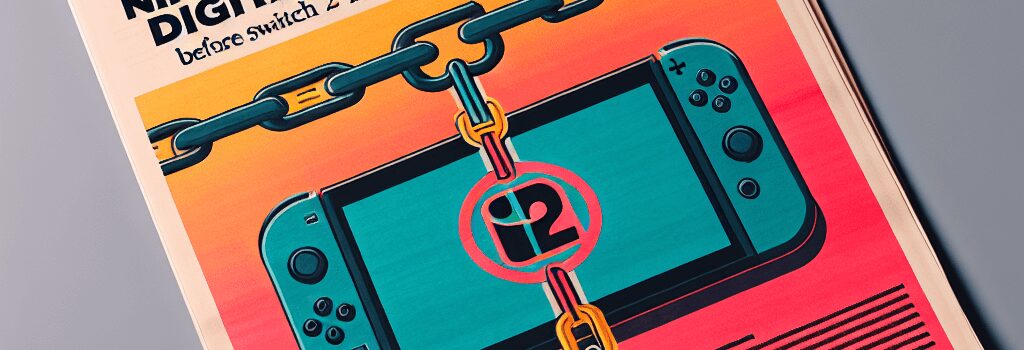Nintendo Limits Digital Game Sharing Before Switch 2 Launch

As Nintendo gears up for the June debut of its next-generation Switch 2, the company has rolled out a major firmware update to the original Switch. This update—introducing the new “Virtual Game Card” and enhanced “Online License” features—fundamentally changes how digital download licenses are managed across multiple consoles. While Nintendo positions these additions as streamlined tools for families, many players are finding that simultaneous online play from a single purchase is now all but blocked.
Virtual Game Card: Technical Overview
The Virtual Game Card (VGC) is essentially a software‐only replica of the old physical cartridge, backed by a cryptographically signed license token stored in Nintendo’s secure element. When you “load” a VGC onto a console, the Switch contacts license.nintendo.net over TLS 1.3, authenticates via OAuth 2.0 with the user’s Nintendo Account, and downloads a time-limited JSON Web Token (JWT). That token unlocks the game’s AES-encrypted data blobs on the local SD card. Once the JWT is active, offline play is fully supported until the token’s expiration (typically 72 hours).
- Secure element: A dedicated chip (renamed SE50 in the Switch 2) that protects private keys.
- Token caching: JWTs are cached in flash and refreshed automatically when online.
- Fail-safe measures: Automatic unload after prolonged inactivity or token revocation.
According to Nintendo’s developer liaison, “This architecture mirrors industry-standard DRM in mobile and console ecosystems, but with user-friendly load/unload operations. It prevents piracy while permitting families to share games responsibly.”
Online License Feature Deep Dive
For households with more than two Switch units, Nintendo’s update surfaces an “Online License” toggle buried in System Settings > Users > Your User > Authentication. When enabled, any console launching a digital title without a VGC initiates a server-side permission check:
- Console sends game ID and account token to NEX (Nintendo Extended Services).
- Server verifies purchase history and concurrently-active sessions (max 1 per title).
- On success, the game lifts the local restriction; on failure, the user sees “Error code 2127-1502.”
This design is intended for more fluid sharing across three or more devices, but only one active online session per title is permitted—effectively disabling parallel online play on multiple consoles.
Comparing Old and New Sharing Models
Under Nintendo’s previous sharing model:
- The first console registered to the purchasing account was the “primary”; all local users could play any owned game offline.
- Secondary consoles required an internet check at launch, but simultaneous play on primary and secondary was allowed for the same title.
That old arrangement, while sometimes fiddly to set up, granted considerable flexibility. As Nintendo’s March FAQ explained, two users could use the same purchase to play concurrently—provided the buying account was active on the secondary console. However, Nintendo has now removed any mention of concurrent play from its public documentation, replacing it with a single link to the new VGC FAQ.
Impact on Multiplayer and Workarounds
Ars Technica’s independent tests confirm that initiating a second online session for a loaded VGC immediately suspends the first: “Play is being suspended on another console.” This holds even when:
- Each Switch uses a different member of the same family group.
- One console has the VGC loaded and the other uses the Online License check.
A partial workaround relies on setting the first Switch to Airplane Mode (or disabling Wi-Fi) while retaining the loaded VGC. Enabling Online License on the purchaser’s account then allows a second console to play online simultaneously. This hack, however, renders the first console offline—disabling any DLC that requires a live Nintendo Switch Online subscription or real-time leaderboard updates.
Expert Insights and Industry Context
“Nintendo’s move closes a loophole that digital marketplaces generally discourage,” says Dr. Maria Chen, a game-industry DRM specialist at DigiRights Analytics. “It aligns their sharing policy with the precedent set by PlayStation and Xbox ecosystems, where concurrent sessions are tightly controlled.”
Cloud gaming services such as NVIDIA GeForce Now and Xbox Cloud Gaming also impose per-session limits tied to each purchase, suggesting that Nintendo is standardizing its approach across platforms. “From a server-cost perspective,” adds Chen, “limiting concurrent sessions caps bandwidth and authentication requests, reducing infrastructure overhead.”
Security and Privacy Considerations
By migrating to a token-based license system, Nintendo enhances security—but also collects more metadata on user habits. Each load/unload or online license check is logged, enabling granular auditing of play sessions. Privacy advocates caution that without clear retention policies, this data could persist indefinitely. Nintendo’s current privacy policy promises deletion after two years, but industry analysts recommend transparency dashboards to build consumer trust.
Future Outlook and Recommendations
With the Switch 2’s higher price point and expanded 4K streaming ambitions, Nintendo wants each player to own a full copy of every game—especially online-centric titles like Mario Kart World, which now lists at US $79.99. Multi-Switch households may be nudged toward bulk purchases or Nintendo’s GameShare feature, currently limited to a handful of first-party titles.
For greater flexibility, Nintendo could consider:
- Introducing a family pass license with tiered concurrent-session allowances.
- Allowing limited simultaneous VGC loads (e.g., two devices) before enforcing unloads.
- Implementing temporary grace periods for peer-to-peer LAN multiplayer without account checks.
In the meantime, gamers will need to weigh the convenience of digital libraries against these stricter sharing rules—especially as Nintendo ramps up subscriptions and digital-only titles on the Switch platform.